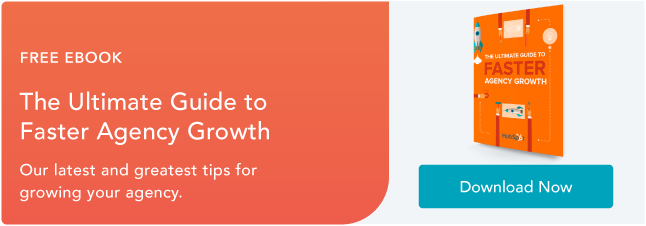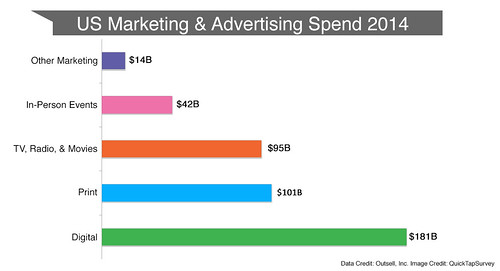Scaling an agency is against its natural growth pattern.

For a professional services firm, it’s most valuable resource is time. To add more of this resource, you need more people. More creatives, account strategists, and project managers means you need more hiring managers and operations people to support them and more new business reps to bring in new clients to keep them busy. More people means more office space or another office and more overhead. It goes on and on …
Agencies become bloated, rather than more efficient, which is why growth is so difficult to achieve.
Some firms have begun to develop intellectual property to “future proof” their businesses, create sustainable forms of revenue, and to learn product development and user acquisition skills that are increasingly an attractive force for clients. Agencies have the talent, but there are few using it to expand beyond client services.
Gray MacKenzie and Andrew Dymski, co-founders of GuavaBox, found this scale issue one of the most frustrating aspects of running a small agency. They would sell and find great success in bringing on new clients, but then they’d have to turn their attention to client service issues. Once they did this, their lead pipeline would dry up. It was a never-ending cycle.
They tackled the problem by launching DoInbound, a project management software that helps inbound marketing agencies achieve scale through more efficient service delivery and project management.
Growing Pains and Processes
MacKenzie and Dymski launched GuavaBox in 2011, during their senior year of college. They started out doing website design, social media marketing, and other digital projects after classes and during weekends.
They had to learn fast and on-the-job. They had no sales experience, no idea what operations were, no experience with invoicing and accounts receivable, and no clue as to how they could scale the business.
And they quickly became jaded with selling website redesign and one-off projects that did little improve the course of their clients' businesses. They needed a different operating model, so GuavaBox became a HubSpot Partner Agency in 2012, transitioning to selling inbound marketing retainers.
And what they found with inbound marketing is that for most clients, you have a key set of activities that you execute on for every client. A campaign means you need a landing page, thank you page, a valuable piece of content, emails, promotional blog posts, social media messages, a talking points sheet for sales, etc.
But without processes and a plan for future campaigns and promotions, the client was skeptical of success and confused about what was actually happening each month and what the next steps were.
“We lost a couple clients early on that were great opportunities and that we were delivering OK results to because we weren't telling the story well to the client,” Dymski said. “We weren't engaging their internal culture about what inbound is. We were really just an outsourced agency that was there to help them bring in leads and that was the end of it. There was no cultural movement behind it.”
They also struggled with training new hires and maintaining consistently high quality output across the team.
Dymski first thought that a project management tool would solve their problems. After the fifth tool, though, he reconsidered that approach.
“We thought we were looking for a software, but really, we were looking for a system to run our agency,” Dymski said.
Another tool wasn’t going to save GuavaBox from poor delivery. They needed to apply an operational mindset to their marketing services. By standardizing the steps and actions taken on each client project, they could make things more scalable.
Now, this idea seems counterintuitive to some agency professionals: Each client has unique challenges and needs. Agencies don’t just “churn out” work.
“While I think there is a degree of customization that happens with every client to make inbound really special and really work, I think the baseline for it needs a strong operational process,” Dymski said. “If you pull that operational process out of it, there's chaos. You can't really be creative when you're stressed out trying to meet deadlines. If you implement that operational process and you have something that's repeatable, I think you free the team.”
Making the Process Scale
Before they went any further into looking at more tools, they developed what they call an inbound game plan. It’s a three-phase process that outlines every step from onboarding to campaign creation to getting results.
DoInbound 's features were built around this approach. Each campaign is broken down into deliverables and each deliverable is broken down into a list of tasks with associated checklists.
“It's the operating manual for your agency, but it's not like your process documents that sit on a shelf and never get read," Dymski said. "Every time I assign a task to my team, it has a checklist with the tasks so your processes live where your work is done. Those two things coming together, reimagining the way agencies organize their business and then having a platform that follows that structure, has been a big benefit to the agencies [who use it].”
In addition, the team provides training for agency leaders trying to learn how to optimize their workflows and want to build their own model for delivering services without having to test and try out every approach.
With this system and a tool for making it repeatable and trackable, agencies can be more confident going into the sales process, knowing they have a defined process for getting projects completed and obtaining goals.
“We're like airline pilots, where a prospect shows up at airport A and it's our job to get them safely from airport A to airport B,” Dymski said. “As inbound marketers, we need to know how to leverage the power of all these tactics based on their situation to get them where they need to be. Documenting every phase of that streamlines that process because you don't need to reinvent the wheel every time. If you came up with a solution to a problem six months ago with another client, and you've documented that deliverable, now you know how to go out and do it for another client. And you've increased your profit margins just like that.”

Diversifying Your Business
Since launching DoInbound, Dymski and MacKenzie have limited the growth on the GuavaBox agency side. Instead, they're focusing on acquisition for the project management software.
“It's the impact lever," Dymski said. "With a SaaS product, you can impact a lot of lives a lot faster than you can with an agency. Because when you're building an agency, your limiting factor is the size of your team. With the software product, you're basically building and honing one platform. Every improvement that you make to the platform is a blessing to every customer who uses that platform.”
It also allows the co-founders to keep their team small, maintain the flexibility in their lives they value, and create a more sustainable business model through revenue source diversification. And their experience in developing, launching, and acquiring users for a SaaS product is experience they can one day leverage into new business for GuavaBox -- they’ve made their own firm their best case study.
And they're using the lessons learned from DoInbound and GuavaBox to improve both sides of the business.
“Building a game plan training course has helped us build much better game plans for our clients because you have to dissect everything that you're doing and then communicate it in a way that can be approachable to other people,” Dymski said. “There's been areas where DoInbound has improved GuavaBox and where GuavaBox actually serves something to a client, and we find nuggets that we bring back to DoInbound to make the platform a lot better.”






![10 Things Your Agency Should Be Doing to Grow Faster [Charts]](http://53.fs1.hubspotusercontent-na1.net/hubfs/53/00-Blog_Thinkstock_Images/agency-growth-1.png)
![How to Turn a Web Project Into a Growth-Driven Design Retainer [+Free Webinar]](http://53.fs1.hubspotusercontent-na1.net/hubfs/53/00-Blog-Related_Images/Growth_Driven_Design_.jpeg)




